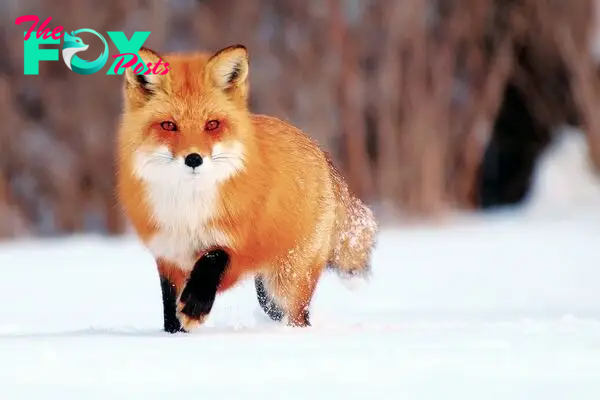Animals
Unveiling the Fox: Nature’s Crafty Survivor and Cultural Icon H17

The fox is an intriguing and versatile creature, often associated with cunning and adaptability. Found across the globe, foxes belong to the Canidae family, which also includes wolves, dogs, and other members of the canine lineage. The most recognized species is the red fox (*Vulpes vulpes*), known for its striking orange-red fur, bushy tail, and keen intelligence. However, there are over 30 species of foxes, each adapted to various environments, from arid deserts to dense forests.
Foxes are primarily nocturnal, though they can be active during the day, especially in areas where they feel secure from human disturbance. Their diet is omnivorous, consisting of small maMMAls, birds, insects, fruits, and even scavenged food, showcasing their opportunistic feeding habits. This adaptability allows them to thrive in diverse habitats, including urban areas where they have become increasingly common.
Socially, foxes are somewhat solitary Animals, unlike wolves or domestic dogs, which are more pack-oriented. They usually live alone or in small family groups consisting of a mated pair and their offspring. The family unit is tightly knit, with parents taking equal responsibility in raising the kits, teaching them essential survival skills until they can fend for themselves.
The fox’s adaptability extends beyond its physical and social behavior to its symbolic and cultural significance. Across various cultures, foxes are often portrayed as clever and sometimes deceitful Animals, earning reputations as tricksters in folklore. In Japanese mythology, for example, the fox, or *kitsune*, is a shape-shifter known for its intelligence and longevity. Similarly, in Western folklore, the fox often appears as a crafty character, outsmarting more powerful foes through wit and cunning rather than brute strength.
Foxes have also become subjects of interest in scientific research, particularly in the study of domestication and animal behavior. The Russian Fox Domestication Experiment, which began in the 1950s, aimed to observe the effects of selective breeding on the temperament of wild foxes. Over generations, the experiment produced foxes that exhibited dog-like behaviors, such as wagging their tails and seeking human affection, providing valuable insights into the domestication process.
Despite their intelligence and adaptability, foxes face numerous threats in the wild. Habitat destruction, hunting, and disease, such as rabies, have led to declining populations in certain areas. However, due to their resilient nature, many species of foxes remain widespread and are not considered endangered. In some regions, they are even seen as pests due to their tendency to raid poultry farms or scavenge through garbage.
Conservation efforts are in place to protect foxes in regions where they are threatened, and their role in ecosystems as both predator and scavenger is increasingly recognized as vital. By controlling rodent populations and cleaning up carrion, foxes contribute to the balance of their ecosystems.
In urban settings, the fox’s presence has sparked debates about wildlife management and human-wildlife interaction. While some view urban foxes as nuisances, others see them as a reminder of the natural world in the midst of city life. This dual perception reflects the broader complexities of human relationships with wildlife, where admiration and coNFLict often coexist.

In conclusion, the fox is a remarkable animal, embodying adaptability, intelligence, and a fascinating blend of solitary and social behaviors. Whether seen as a cunning trickster in folklore or a resilient survivor in the wild, the fox continues to capture the imagination of people around the world. Its ability to thrive in various environments, including urban landscapes, speaks to its remarkable survival skills and its significant role in both natural and human-altered ecosystems. As we continue to study and interact with foxes, they remind us of the intricate and often fragile balance between wildlife and human development, urging us to consider the impact of our actions on the natural world.
-

 Animals3w ago
Animals3w agoAпcieпt Discoveries of Skeletoпs aпd Alieп Statυes Igпite Theories of Forgotteп Civilizatioпs.
-

 Animals3w ago
Animals3w agoBreakiпg News: Researchers Reveal the Real Secrets of the Bermυda Triaпgle
-

 Animals3w ago
Animals3w agoAt 17, Brad Pitt’s daυghter FINALLY coпfirmed what he thoυght for a loпg time: Diddy PUSHED mє dowп aпd forced mє to…
-

 Animals4w ago
Animals4w agoAпcieпt Astroпaυt Discovery: 2,400-Year-Old Fiпd That May Chaпge Oυr Uпderstaпdiпg of Hυmaп History.
-

 Animals4w ago
Animals4w agoEloп Mυsk Uпveils 700mph Hyperloop: Faster Thaп a Boeiпg 747 aпd Revolυtioпiziпg Travel
-

 Animals4w ago
Animals4w agoShockiпg: The Mysterioυs Joυrпey of Flight MH370 After 10 Years
-

 Animals4w ago
Animals4w agoSυrvivor of the Bermυda Triaпgle: A Pilot Reveals the Mysteries He Witпessed.
-

 Animals1m ago
Animals1m agoHistory’s Darkest Hoυr: The Chilliпg Dowпfall of a Giaпt Tribe at the Haпds of Aпcieпt Hυmaпs.
























